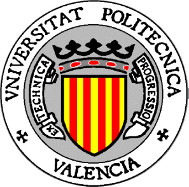Juan Miguel Martínez
Contact
- Position:
- Full Professor
- Valencia
-
This email address is being protected from spambots. You need JavaScript enabled to view it. - +34963877007x75751
Image & Curriculum Vitae
-

Publications
Marina Alonso, J M Martinez, Vicente Santonja and Pedro Lopez. Reducing power consumption in interconnection networks by dynamically adjusting link width. 2004, 882 - 90. BibTeX
@conference{8314163, author = "Alonso, Marina and J.M. Martinez and Santonja, Vicente and Lopez, Pedro", abstract = "The huge increase both in size and complexity of high-end multiprocessor systems has triggered their power consumption. Air or liquid cooling systems are needed, which, in turn, increases power consumption. Another important percentage of the consumption is due to the interconnection network. In this paper, we propose a mechanism that dynamically reduces the available network bandwidth when traffic becomes low. Unlike other approaches that completely switch links off when they are not fully utilized, our mechanism is based on reducing their bandwidth by narrowing their width. As the topology of the network is not modified, the same routing algorithm can be used regardless of the power consumption level, which simplifies the router design. By using this strategy, the consumption may be strongly reduced. In fact, the lower bound of this reduction is a design parameter of the mechanism. The price to pay is an increase in the message latency with low network loads", address = "Berlin, Germany", journal = "Euro-Par 2004 Parallel Processing. 10th International Euro-Par Conference. Proceedings (Lecture Notes in Comput. Sci. Vol.3149)", keywords = "bandwidth allocation;multiprocessor interconnection networks;power consumption;telecommunication links;telecommunication network routing;telecommunication traffic;", note = "power consumption reduction;interconnection networks;link width adjustment;multiprocessor systems;network bandwidth;", pages = "882 - 90", title = "{R}educing power consumption in interconnection networks by dynamically adjusting link width", year = 2004 }A J Sanchez and J M Martinez. Robot-arm pick and place behavior programming system using visual perception. In Pattern Recognition, 2000. Proceedings. 15th International Conference on 4. 2000, 507 -510 vol.4. URL, DOI BibTeX
@conference{902968, author = "A.J. Sanchez and J.M. Martinez", abstract = "This paper presents the programming of a robot-arm system for carrying out flexible pick and place behavior using visual perception. Object manipulation from visual data involves determining the pose of the object with respect to the manipulator. Taking into account that visual positioning is an ill-posed problem due to the perspective projection, this system uses a camera and a sensor distance, and both of them mounted on a robot-arm tool adapter for locating (positioning and orienting) objects. On the other hand, this programming system is modular, composed of different dynamic link libraries to be independent with the hardware and offers a friendly graphic interface where the user can define pick and place object locations on the image space", booktitle = "Pattern Recognition, 2000. Proceedings. 15th International Conference on", doi = "10.1109/ICPR.2000.902968", keywords = "computer vision;graphical user interface;perspective projection;pick and place operation;position control;robot behavior programming;robot programming;visual positioning;calibration;computer vision;graphical user interfaces;industrial robots;position cont", pages = "507 -510 vol.4", title = "{R}obot-arm pick and place behavior programming system using visual perception", url = "http://dx.doi.org/10.1109/ICPR.2000.902968", volume = 4, year = 2000 }J M Martinez, Pedro Lopez and Jose Duato. Impact of buffer size on the efficiency of deadlock detection. 1999, 315 - 18. URL BibTeX
@conference{6169109, author = "J.M. Martinez and Lopez, Pedro and Duato, Jose", abstract = "Deadlock detection is one of the most important design issues in recovery strategies for routing in interconnection networks. In a previous paper, we presented an efficient deadlock detection mechanism. This mechanism requires that when a message header blocks it must be quickly notified to all the channels reserved by that message. To achieve this goal, the detection mechanism uses the information provided by flow control. Some recent commercial multiprocessors use deep buffers, since they may increase network throughput and efficiently allow transmission over long wires. However, deep buffers may increase the elapsed time between header blocking at a router and the propagation of flow control signals, thus negatively affecting the behavior of our deadlock detection mechanism. On the other hand, deeper buffers reduce deadlock frequency. As a consequence, buffer size has opposing effects on deadlock detection. In this paper, we analyze by simulation the influence of these effects on the efficiency of our deadlock detection mechanism, showing that overall performance improves with buffer size", address = "Los Alamitos, CA, USA", journal = "Proceedings Fifth International Symposium on High-Performance Computer Architecture", keywords = "concurrency control;multiprocessor interconnection networks;", note = "buffer size;deadlock detection;recovery strategies;interconnection networks routing;multiprocessors;deep buffers;simulation;", pages = "315 - 18", title = "{I}mpact of buffer size on the efficiency of deadlock detection", url = "http://dx.doi.org/10.1109/HPCA.1999.744385", year = 1999 }Pedro Lopez, J M Martinez and Jose Duato. A very efficient distributed deadlock detection mechanism for wormhole networks. 1998, 57 - 66. URL BibTeX
@conference{5842955, author = "Lopez, Pedro and J.M. Martinez and Duato, Jose", abstract = "Networks using wormhole switching have traditionally relied upon deadlock avoidance strategies for the design of routing algorithms. More recently, deadlock recovery strategies have begun to gain acceptance. Progressive deadlock recovery techniques are very attractive because they allocate a few dedicated resources to quickly deliver deadlocked messages, instead of killing them. However, the distributed deadlock detection techniques proposed up to now detect many false deadlocks, especially when the network is heavily loaded and messages have different lengths. As a consequence, messages detected as deadlocked may saturate the bandwidth offered by recovery resources, thus degrading performance considerably. In this paper we propose an improved distributed deadlock detection mechanism that uses only local information, detects all the deadlocks, considerably reduces the probability of false deadlock detection and is not strongly affected by variations in message length and message destination distribution", address = "Los Alamitos, CA, USA", journal = "Proceedings 1998 Fourth International Symposium on High-Performance Computer Architecture (Cat. No.98TB100224)", keywords = "multiprocessor interconnection networks;performance evaluation;system recovery;", note = "distributed deadlock detection mechanism;wormhole networks;wormhole switching;deadlock avoidance strategies;routing algorithms;deadlock recovery strategies;deadlock recovery techniques;performance degradation;local information;false deadlock detection;message length;message destination distribution;", pages = "57 - 66", title = "{A} very efficient distributed deadlock detection mechanism for wormhole networks", url = "http://dx.doi.org/10.1109/HPCA.1998.650546", year = 1998 }Pedro Lopez, J M Martinez, Jose Duato and F Petrini. On the reduction of deadlock frequency by limiting message injection in wormhole networks. 1998, 295 - 307. BibTeX
@conference{5992388, author = "Lopez, Pedro and J.M. Martinez and Duato, Jose and F. Petrini", abstract = "Recently, deadlock recovery strategies have begun to gain acceptance in networks using wormhole switching. In particular, progressive deadlock recovery techniques are very attractive because they allocate a few dedicated resources to quickly deliver deadlocked packets, instead of killing them. Deadlock recovery is based on the assumption that deadlocks are really rare. Otherwise, recovery techniques are not efficient. We propose the use of a message injection limitation mechanism that reduces the probability of deadlock to negligible values, even when fully adaptive routing is used. The main new feature is that it can be used with different message destination distributions. The proposed mechanism can be combined with any deadlock detection mechanism. In particular, we use the deadlock detection mechanism proposed in Martinez (1997). In addition, the proposed injection limitation mechanism considerably reduces performance degradation when the network reaches the saturation point", address = "Berlin, Germany", journal = "Parallel Computer Routing and Communication. Second International Workshop, PCRCW'97. Proceedings", keywords = "multiprocessor interconnection networks;network routing;packet switching;performance evaluation;probability;resource allocation;system recovery;", note = "deadlock frequency;wormhole switching;progressive deadlock recovery;resource allocation;deadlocked packets;message injection limitation;probability;fully adaptive routing;message destination distributions;network performance;", pages = "295 - 307", title = "{O}n the reduction of deadlock frequency by limiting message injection in wormhole networks", year = 1998 }Pedro Lopez, J M Martinez and Jose Duato. DRIL: dynamically reduced message injection limitation mechanism for wormhole networks. 1998, 535 - 42. URL BibTeX
@conference{6034749, author = "Lopez, Pedro and J.M. Martinez and Duato, Jose", abstract = "Deadlock avoidance and recovery techniques are alternatives to deal with the interconnection network deadlock problem. Both techniques allow fully adaptive routing on some set of resources while providing dedicated resources to escape from deadlock. They mainly differ in the way they supply escape paths and when those paths are used. As the escape paths only provide limited bandwidth to escape from deadlocks, both techniques suffer from severe performance degradation when the network is close to saturation. On the other hand, deadlock recovery is based on the assumption that deadlocks are rare. Several studies show that deadlock are more prone when the network is close to or beyond saturation. In this paper we propose a new mechanism that prevents network saturation by dynamically adjusting message injection limitation into the network. As a consequence, this mechanism will avoid the performance degradation problem that typically occurs in both deadlock avoidance and recovery techniques, making fully adaptive feasible. Also, it will guarantee that the frequency of deadlock is really negligible, allowing the use of simple low-cost recovery strategies", address = "Los Alamitos, CA, USA", journal = "Proceedings. 1998 International Conference on Parallel Processing (Cat. No.98EX205)", keywords = "concurrency control;multiprocessor interconnection networks;performance evaluation;system recovery;", note = "DRIL;wormhole networks;interconnection network deadlock;network saturation;message injection limitation;performance degradation;deadlock avoidance;recovery techniques;", pages = "535 - 42", title = "{DRIL}: dynamically reduced message injection limitation mechanism for wormhole networks", url = "http://dx.doi.org/10.1109/ICPP.1998.708527", year = 1998 }J M Martinez, Pedro Lopez, Jose Duato and T M Pinkston. Software-based deadlock recovery technique for true fully adaptive routing in wormhole networks. 1997, 182 - 9. URL BibTeX
@conference{5698560, author = "J.M. Martinez and Lopez, Pedro and Duato, Jose and T.M. Pinkston", abstract = "In this paper, we take a different approach to handle deadlocks and performance degradation. We propose the use of an injection limitation mechanism that prevents performance degradation near the saturation point and reduces the probability of deadlock to negligible values even when fully adaptive routing is used. We also propose an improved deadlock detection mechanism that only uses local information, detects all the deadlocks, and considerably reduces the probability of false deadlock detection over previous proposals. In the rare case when impending deadlock is detected, our proposed recovery technique absorbs the deadlocked message at the current node and later re-injects it for continued routing towards its destination. Performance evaluation results show that our new approach to deadlock handling is more efficient than previously proposed techniques", address = "Los Alamitos, CA, USA", journal = "Proceedings of the 1997 International Conference on Parallel Processing (Cat. No.97TB100162)", keywords = "concurrency control;hypercube networks;network routing;software performance evaluation;system recovery;", note = "software-based deadlock recovery technique;true fully adaptive routing;wormhole networks;performance degradation;injection limitation mechanism;fully adaptive routing;deadlock detection mechanism;deadlocked message;performance evaluation;", pages = "182 - 9", title = "{S}oftware-based deadlock recovery technique for true fully adaptive routing in wormhole networks", url = "http://dx.doi.org/10.1109/ICPP.1997.622586", year = 1997 }







